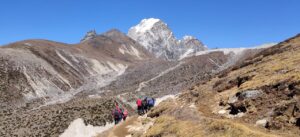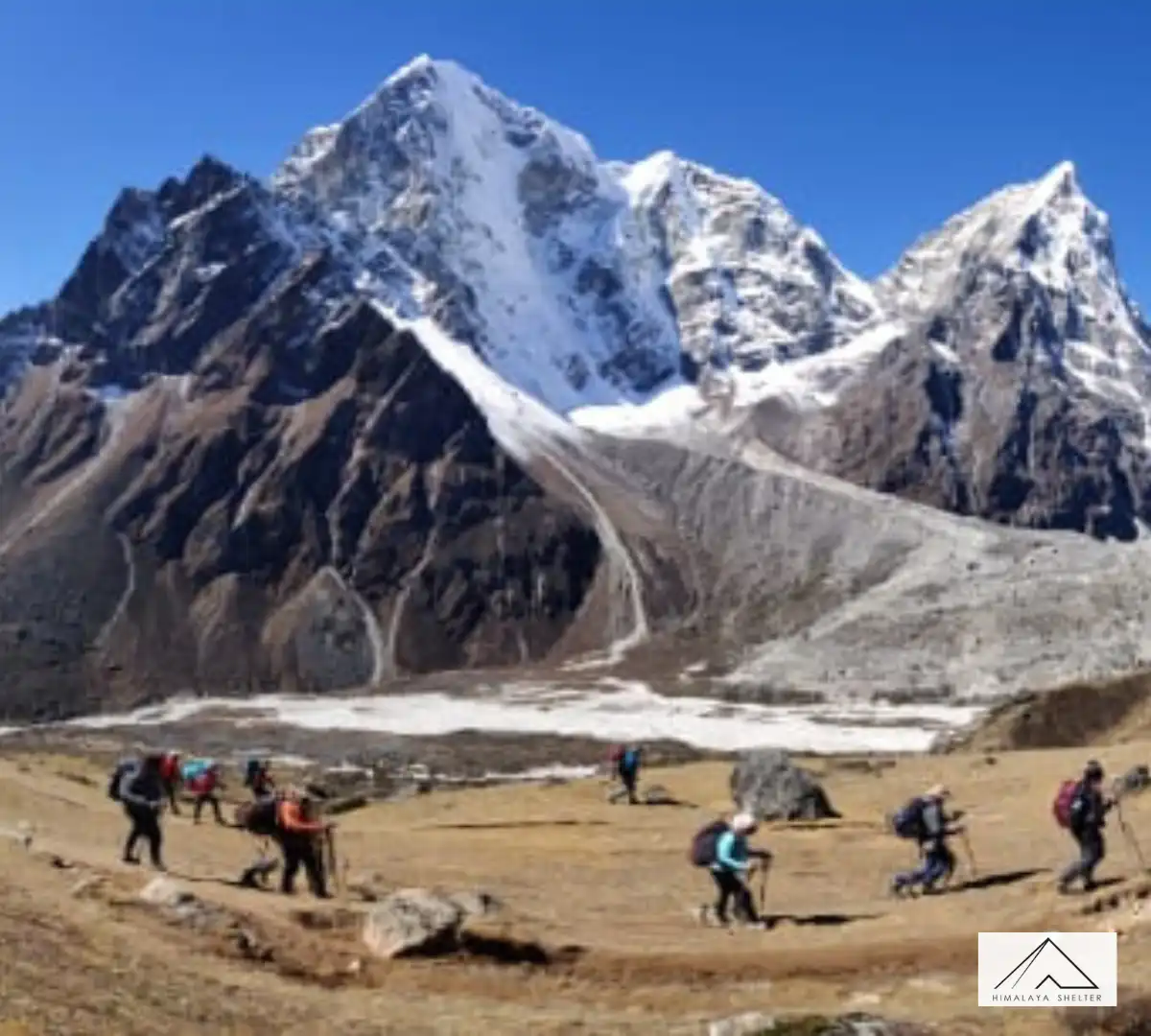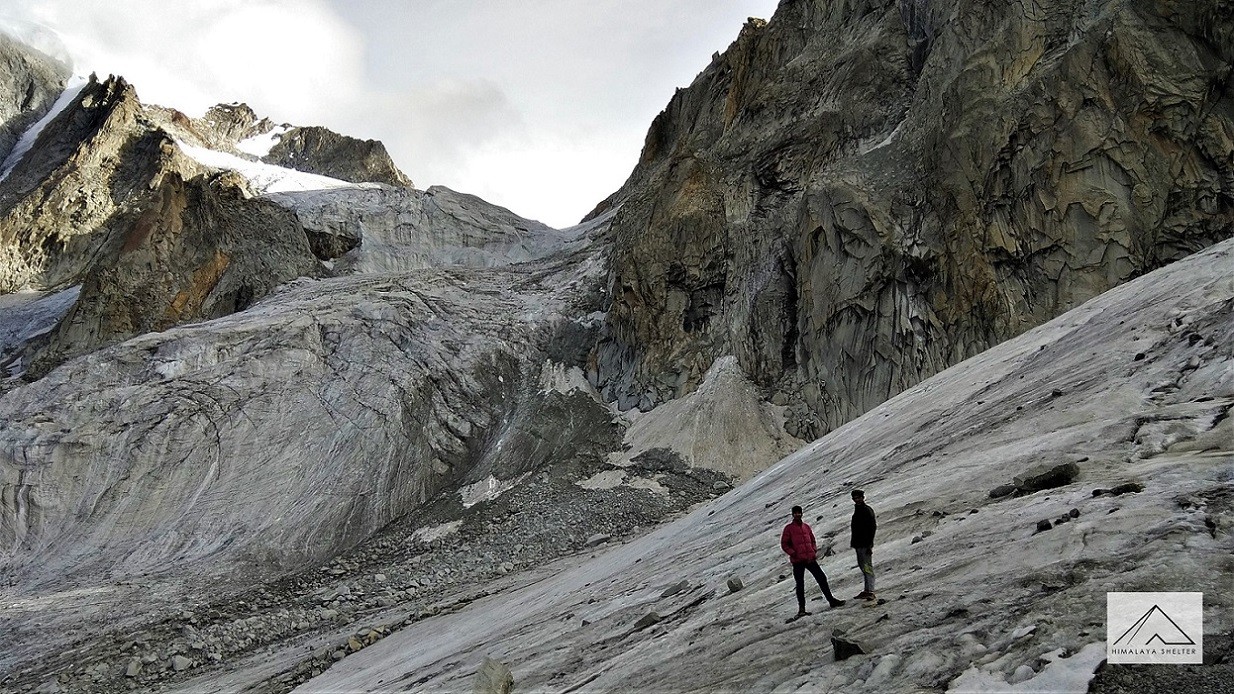
Everest Base Camp Nepal
TREK DIFFICULTY
Easy
TREK DURATION
15 Days
HIGHEST ALTITUDE
5550 meter
GROUP SIZE
9-12
TREK DISTANCE
130 KM
BASECAMP
Nepal
BEST TIME
March | April | May and October | November
PICKUP POINT
Nepal
Everest Base Camp Nepal Overview
The North Base Camp in Tibet and the South Base Camp in Nepal are the two base camps for Everest treks. The terminus of this fabled walk is the Nepalese camp in the Khumbu area, which is commonly referred to as Everest Base Camp in Nepal. It's hidden away at the end of a lengthy valley that splits at the Sherpa settlement of Dingboche and cuts into the Himalayas. Right outside the camp, the difficult Khumbu Icefall, the first challenge for anyone trying an Everest summit push, starts to ascend to the Western Cwm, the peaks of Lhotse and Nuptse, also known as the Valley of Silence.

The Everest Base Camp Nepal Trip is possibly the most well-known trek in Asia, and possibly the whole globe. The path has recently seen congestion and some pollution. Nothing, however, can compare to the exhilarating sense of adventure that comes with making the ascent to the very edge of the highest mountain in the world. When you get a jaw-dropping broadside of Mount Everest from a viewpoint on the south side of Ama Dablam in the early going of your journey, this reaches a fever pitch.
The trek's rewards aren't always easy to come by. Everest Base Camp Nepal is a high-altitude route that takes a significant amount of time to acclimatize to. The 80-mile (130-km) journey from Lukla usually takes 12–14 days of intense trekking (yes, even your "rest days" require walking!). However, the reason the entire journey takes so many days is that it needs to be broken down into manageable portions owing to the altitude, with acclimatization and rest days thrown in. The majority of itineraries allow enough time to finish each leg in a single day at a speed significantly slower than the standard trekking pace.
To protect the natural splendour of Mount Everest and other summits in the Himalayan range, the government of Nepal charges permit admission fees. Permits are required for entry to all national parks in Nepal, and the Sagarmatha National Park is no exception. It is an investment in the future of this stunning region, which is home to snow, woods, ice, meadows, and a rich cultural heritage. The Khumbu may have been popularized by Sir Edmund Hillary and Tenzing Norgay, but numerous climbers and trekkers have since admired the splendour of places like Mt. Everest, Ama Dablam, Goyko Lakes, and many others. The Everest Base Camp Nepal (EBC) Trek requires the following admission permissions, which are described below: 1.Entrance Permit from Khumbu Pasang Lhamu Rural Municipality (NPR 2000 per person). 2.Entry Permit for Sagarmatha National Park (NPR 3000 Per Person)
The following variables determine the overall cost of the Mount Everest Base Camp Trek: 1. Kathmandu costs 2. Transportation costs 3. Visa fees for Nepal 4. The price of trekking licences 5. The cost of lodging while trekking to Everest Base Camp 6. Cost of food and water for the trip to Everest base camp 7. Guide and porter fees for the journey to Everest base camp 8. Travel Insurance Cost 9. The Price of Trekking Gear 10. Cost of VAT (Value Added Tax)
Pre- and post-monsoon, or March–May and October–November, respectively, are the two primary trekking seasons to reach Everest Base Camp. It is also feasible to go outside of these months; however, owing to the weather, these would be the busiest seasons. It starts chilly and grows warmer from March to May, and the opposite is true after the monsoon.
One of the most well-known trek is the Everest Base Camp Nepal, which is situated at a height of 5550 meters. The trip gives breath-taking views of the picturesque scenery of well-known mountains like Ama Dablam, Lhotse, Pumori, Nuptse, and others; a walk amid the enormous Himalayan mountains; a taste of local food; and travel following the aforementioned directions.
Day 1: Day 1 . Arrive in Kathmandu (1,330M)
The first day is set aside for travel to Nepal’s busy metropolis of Kathmandu. Its vibrant, congested alleys filled with shops piled high with climbing and trekking equipment, together with the numerous tourist hotels and cafés with tall mountains in the background, are enough to imply that hiking in Nepal will be an entirely unique experience. This location is your best bet if you need to buy some top-notch equipment, at the best prices, for your future climbs or if you are missing something for the one you are on right now! Crowds from all over the world are sifting through the city in search of climbing gear suited for the highest mountains!While Indian currency is accepted at Kathmandu’s stores and cafés, you might wish to use this day to convert your money into Nepali rupees as the upper portions of the trek only accept cash, and the only currency accepted in the tea houses above is the local currency.
Day 2: Day 2 . Kathmandu (1,330M) to Lukla (2,860M) to Phakding (2,652M):
Duration: 35 min (flight to Lukla) + 3 hours (trek to Phakding):
Distance: 7 km trek
We take a quick flight up to the trailhead before starting the walk on this day. Proceed to Tribhuvan Domestic Airport in Kathmandu after breakfast to catch our aircraft to Lukla. One of the highlights of this walk might easily be the 35-minute fly over the mountains in the Khumbu Region, which offers some of the most beautiful views in Nepal. The view out the window on these little planes is something you won’t soon forget if you score a seat on the left side. Only flights or foot travel are available to get to Lukla, a little town without a road.The first day of hiking must be formally started by walking directly from the airport across the village’s cobblestone sidewalk and into the woodland route. You must produce the first of our two permits at the checkpoint just before leaving the settlement, so have them close at hand. Today’s hike is straightforward; it lasts for three hours and begins with a 300-meter descent before gradually ascending 100 metres to reach Phakding, the overnight rest stop. Numerous mani walls painted on the trail’s rock walls and boulders with Tibetan Buddhist prayer inscriptions must be passed along the route. Along the route, there are a lot of prayer wheels as well. The first night of their trek, tourists will stay at a tea house in Phakding.

Day 3: Day 3 Phakding (2,652M) to Namche Bazaar (3,440M):
Duration: 6-7 hours, Distance: 11 km
From now on, it’s business as usual because today is the first day of this trek’s encounters with challenging terrain. The Dudh Kosi will be your first major river to cross, and you’ll do it twice on the tall suspension bridges that make Everest Base Camp Nepal treks so well-known. The route follows the river and repeatedly crosses the distinctive local Buddhist stones as it ascends and descends in short, repetitive steps. The hamlet of Monjo, which serves as the entrance to Sagarmatha National Park, is where you will make a lunch break. You should now hand over the second of our two licences. As you exit the park, you descend down a large wall covered in Tibetan prayers painted to the sky to the Bhote Kosi River and Jorsalle hamlet. The fun really starts here. The route becomes higher and passes through lush woodlands after one more promenade along the riverbed that resembles a beach. You eventually cross the last suspension bridge of the day, which hangs breathtakingly high over a gorge that is rapidly narrowing. From here, you must climb 600M through a densely wooded area to reach Namche Bazaar, the commercial and administrative centre of the Khumbu district. At the rest stop along the journey, if the weather is clear, you could catch your first glimpse of Everest. Tea house accommodation for the night in Namche Bazaar.
Day 4: Day 4 Namche (3,440M) to Tengboche (3,860M):
Duration: 6-7 hours, Distance: 10-11 km
At 3,860 metres above sea level, Tengboche is a tiny valley. We begin our picturesque journey between the two towns by travelling through Namche on a road built with stones that runs alongside a creek. The panorama is dominated by Thamserku, a stunning peak rising to 6,608 metres, with Ama Dablam, one of the strangest-shaped mountains, farther up the valley. The south faces of Lhotse and Nuptse, which narrow the valley in front of you, meet at a ridge, and Everest is visible above it. The track consists of brief ascents and brief descents, just long enough for you to catch your breath before the next short ascent. By midday, you will arrive at your stop-hold for the day.
Day 5: Day 5 Tengboche (3,860M) to Dingboche (4,410M):
Duration: 5-6 hours
You’ll set out for your trip this morning early, cross the ridge to the other side, and then immediately enter a birch and rhododendron woodland. Lower Pangboche is around 4 km away from here; with a rise in elevation of about 260M, you should be there in less than 2 hours. The sprawling settlement of Pangboche is located just under the majestic Ama Dablam and provides some of the most breathtaking views of the mountain, making it the ideal place to stop for a rest. You either pause for tea or go right to lunch, depending on what time you arrive. From this point on, Everest is no longer visible until you reach the high reaches of the Khumbu Valley. Throughout your hike today, you will pass by several renowned peaks; don’t forget to ask your local guide about them whenever you spot a new peak peeking out from behind at a change in the scenery. The Lobuche River is on your left. After passing across several moraines, Dingboche may be seen. The south face of Lhotse (8,516 metres), which dominates the view, is one of the magnificent sites this huge community has to offer. Don’t forget to watch the sunset from this lovely spot.
Day 6: Day 6 Acclimatization day at Dingboche (4,410M):
Day 7: Day7 Dingboche (4,410M) to Dughla/Thukla (4,620M):
Duration: 3 hours, Distance: 5 km
The trek’s shortest day is today, and it seems easier following yesterday’s rest day at Dingboche. Some of the nicest views on this route may be seen along the flat trek to Dughla, which also provides a breathtaking perspective of the Khumbu Glacier’s wall. You will see the majestic Mount Pumori (7,138m) and a glacier lake with vivid colours on your right. Remember to bring enough supplies of refreshment and water for today as there are no tea establishments or water sources between these two destinations.
Day 8: Day8 Dhugla/Thukla (4,620M) to Lobuche (4,940M):
Duration: 3.5 hours
You begin your trip today in the direction of Lobuche, which is located close to the Khumbu glacier. The first portion of the journey is challenging as you make the arduous ascent to Dughla Pass or Thukla Pass before continuing on to Lobuche. If it’s any consolation, the brief but incredibly steep ascent gives some of the trek’s most unforgettable vistas. The trail is mainly level after the pass, so you will spend some time there before continuing on to Lobuche.
Day 9: Day9 Lobuche (4,940M) to Gorakshep (5,164M) to Everest Base Camp (5,364M) and back to Gorakshep (5,164M):
Duration: 7 – 8 hours
Up to Gorakshep, the path features several ups and downs, the majority of which are humps on the iconic Khumbu Glacier’s moraines. After eating once you get in Gorakshep, you will immediately go to travel to Everest Base Camp, which is located at the start of the enormous Khumbu Glacier. The route follows a glacier with breathtaking views of Mounts Pumori and Nuptse to your right and left, respectively. From the base camp, you get a clear-as-day view of the Khumbu icefall, which should motivate you to improve your trekking skills. The experience of being surrounded by giants is almost unbelievable as you come face to face with some of the largest mountains in Everest Base Camp Nepal and the entire globe during this part of the journey. To reach Everest Base Camp, you must briefly trek on the Khumbu glacier, which gives you a small taste of what it must be like to ascend this enormous mountain. Before returning to Gorakshep on the same path, you will spend some time at the base camp taking in the scenery.
Day 10: Day 10 Gorakshep (5,164M) to Kala Patthar (5,644M) to Pheriche (4, 371M):
Duration: 7 – 8 hours
The trek’s most thrilling day is today. With breathtaking vistas, it is everything you have been secretly anticipating the entire time. It will take some work for you to get to Kala Patthar, but it is a site kind enough to provide you the best views of Everest on this entire journey. One of the toughest but most worthwhile treks is to the top of Kala Patthar. After the walk to Kala Patthar, it is simple to see why Everest is the peak that people are most interested in climbing and why this has happened throughout history. In fact, Kala Patthar is the only location from which you can get views of practically the whole Khumbu Range’s high peak mountains, which is why making the trek there is so motivational. From Gorakshep, it takes around 3 hours to go to Kala Patthar. Since there is nothing to stop the violent gusts, it is impossible to spend much time on the summit.
The only way to get to Pheriche from Kala Patthar is to descend. It should take roughly 4 hours to descend over 1,300 metres. On the Dhudhkoshi River’s bank, in a level valley, is the town of Pheriche.
Day 11: Day 11 Pheriche (5,644M) to Namche Bazaar (3,440M):
Because of the breathtaking scenery you saw on day 10, today’s modest hike is made easier. Before Tengboche and after Phungi Thanga, there are a few smatterings of climb.
Day 12: Day 12 Namche Bazaar (3,440M) to Lukla (2,860M):
The final day of your walk in the breathtaking Khumbu area must be enjoyed. You may more fully appreciate the beauty of this well-traveled route by walking along it without having to worry about getting used to it. This is a stroll in the park when there is no urgency to go anyplace
Day 13: Day 13 Fly to Kathmandu from Lukla and transfer to your Hotel 1 hour:
On the last day of the journey, you’ll board a stunning aircraft to return to Kathmandu. waving tearful goodbye to the lovely mountains once more. Finally, you will arrive at Kathmandu airport and be taken to the appropriate hotel.
Trip Cost Includes
- Accommodation ● Day 2 and Day 13 you will be staying in Tea-House
- Team ● Certified English Speaking Guide ● Assistant Guide and other staff
- Meals ● All meals from Day 2 ( dinner ) Lukla to Day 13 ( Breakfast ) Lukla
- Medical Facility ● First aid medical kit and oxygen cylinder
- All Permits ● Khumbu Municipality Fees
- Service from Lukla to Lukla
- Trek Completion Certificate
Trip Cost Excludes
- Extra Expenses ●All optional additional tours or activities during free time ●Porters for the personal bag ●Phone charging, Charging batteries, hot showers
- International or National Air Fare Visas
- Travel Insurance
- Tips
Read More on Everest Base Camp Nepal
Photo Gallery








Treks by Categories
Treks By Month

Treks By Experience





















